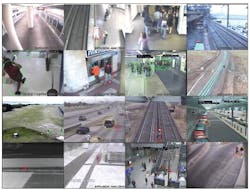Over the past decade, the reliability and functionality of video analytics have advanced to a point where, for many security operations, it is no longer a question of “should we use video analytics?” But rather, “How should we implement video analytics within our technical architecture?”
There are two main options for implementing video analytics software and, depending on the environment, either can be effective. The software containing the video analytics algorithms can be located in one of two broad areas: inside an IP camera (referred to as the edge, as it is at the edge of the network) or on a centralized server (referred to as the center or server-based). A derivative of the edge approach can be used for analog cameras that lack the computing power to run embedded analytics. This is done by placing the video analytics software on video encoders, which are also at the edge of the network.
There are pros and cons to both edge- and server-based approaches. Understanding these differences can help system integrators advise their customers on the optimal approach. For some projects, a combination of both approaches can yield superior results. This method is especially applicable at electric utilities or other organizations that have a number of large facilities as well as many smaller remote locations and limited bandwidth.
The "Tale of the Tape" table (download a full PDF here: www.securityinfowatch.com/11518834) describes the criteria for making a decision on whether to run video analytics on the edge or in the center. For an integrator, understanding your customer’s specific environment and requirements will help determine the relative importance of each criterion.
In addition to the parameters outlined, there are other factors that system integrators should consider, such as how the analytics will be used and where the captured video will be stored. Storage is especially important when using advanced forms of video analytics, since they rely on captured video.
Additional considerations with advanced video analytics
In simple video analytics applications, the software analyzes the video, checks for anomalies, and generates an alarm. Advanced video analytics, on the other hand, also record summaries of what the analytics analyze. A good example of this is using video analytics to review the past 24 hours of recorded video to show all of the instances where a person wearing a reddish jacket walked through the scene. The same concept can be applied to size, object, speed, trajectory (direction), aspect ratio or license plate numbers. These more advanced types of video analytics applications generate this hidden information, called metadata, for future use.
In order to query this metadata as part of a forensic search, it must be stored with the video on the NVR, and the VMS must have the interface to query it. This is why it is necessary for the video analytics vendor to partner closely with the VMS vendor; in fact, for highly sophisticated video analytics applications, it is not uncommon for all of the components to be offered as a single-source solution.
What to choose?
Edge analytics are particularly advantageous for remote locations with limited bandwidth. They can be a very effective solution at an attractive price. With the advantage of more CPU power, server-based analytics can run more analytics per camera. Since they are camera agnostic, you have the flexibility to select different cameras based on desired functionality and location requirements.
If your customer is unfamiliar with video analytics and wants to test the analytics with an existing camera, a server-based pilot is the simplest way. If the customer uses IP cameras, all it’ll need to try it out is an analytics license on the server. If the customer uses older analog cameras, you can simply send a copy of the analog signal through a single channel encoder and get results instantly.
Dr. Bob Banerjee is Senior Director of Training and Development for NICE Systems' Security Division. A security industry icon, Banerjee has more than a decade of experience, having held senior marketing and global product management positions with several IT and software firms. He holds a Ph.D. in Artificial Intelligence from the Advanced Research Center at the University of Bristol, England. To request more info about NICE, visit www.securityinfowatch.com/10214502.





